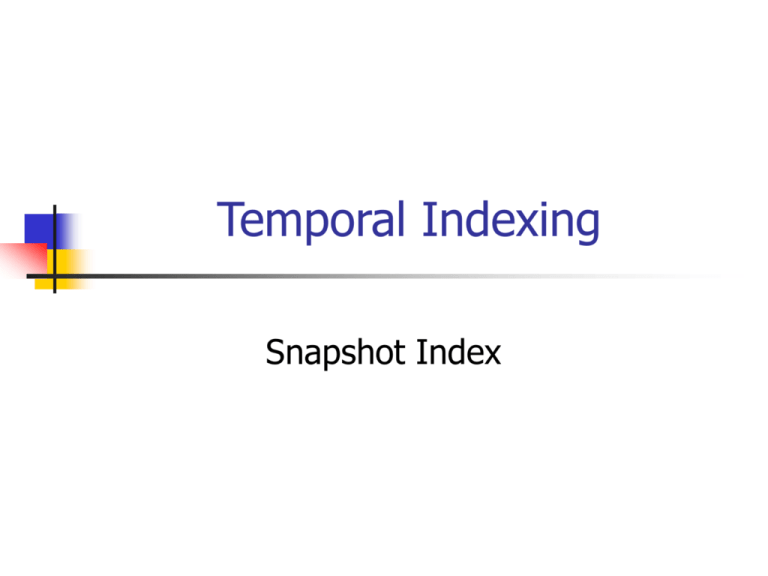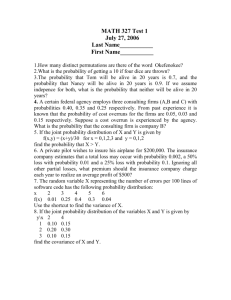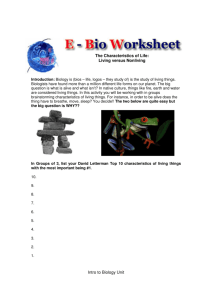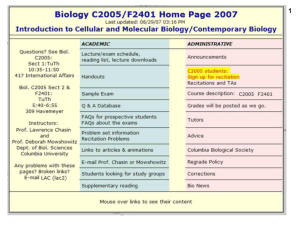PPT
advertisement

Temporal Indexing Snapshot Index Transaction Time Environment Assume that when an event occurs in the real world it is inserted in the DB A timestamp is associated with each operation Transaction timestamps are monotonically increasing Previous transactions cannot be changed we cannot change the past Example Time evolving set of objects: employees of a company Time is discrete and described by a succession of non-negative integers: 1,2,3, … Each time instant changes may happen, i.e., addition, deletion or modification We assume only insertion & deletion : modifications can be represented by a deletion and an insertion Records Each object is associated with: 1. An oid (key, time invariant, eid) 2. Attributes that can change (salary) 3. A lifespan interval [t.start, t.end) An object is alive from the time it inserted in the set, until it was deleted At insertion time deletion is unknown Deletions are logical: we change the now variable to the current time, [t1, now) [t1, t2) Evolving set The state S(t) of the evolving set at t is defined as: “the collection of alive objects at t” The number of changes n represents a good metric for the minimal space needed to store the evolution Evolving sets A new change updates the current state S(t) to create a new state t1 t2 ti a a,h S(ti) time a,f,g Transaction-time Queries Pure-timeslice Range-timeslice Pure-exact match Snapshot Index Snapshot Index, is a method that answers efficiently pure-timeslice queries Based on a main memory method that solves the problem in O(a+log2n), O(n)space External memory: O(a/B + logBn) MM solution Copy approach: O(a + logn) but O(n2) space Log approach: O(n) space but O(n) query time We should combine the fast query time with the small space (and update) Assumptions Assumptions (for clarity) 1 At each time instant there exist exactly one change Each object is named by its creation time 15 29 46 51 60 64 70 SP 1 15 29 46 60 64 70 80 Access Forest A double linked list L. Each new object is appended at the right end of L A deleted object is removed from L and becomes the next child of its left sibling in L Each object stores a pointer to its parent object. Also a parent object points to its first and last children AF example 1 15 29 46 51 60 64 70 SP 1 15 29 46 60 64 70 SP 29 1 46 15 60 70 64 80 Additional structures A hashing scheme that keeps pointers to the positions of the alive elements in L An array A that stores the time changes. For each time change instant, it keeps the pointer to the current last object in L Properties of AF In each tree of the AF the start times are sorted in preorder fashion The lifetime of an object includes the lifetimes of its descendants The intervals of two consecutive children under the same parent may have the following orderings: si < ei < si+1 <ei+1 or si< si+1<ei < ei+1 Searching Find all objects alive at tq Use A to find the starting object in the access forest L (O(logn)) Traverse the access forest and report all alive objects at tq O(a) using the properties Disk based Solution Keep changes in pages as it was a Log Use hashing scheme to find objects by name (update O(1)) Acceptor : the current page that receives objects Definitions A page is useful for the following time instants: I-useful: while this page was the acceptor block II-useful: for all time instants for which it contains at least uB “alive” records u is the usefulness parameter Meta-evolution From the actual evolution of objects, now we have the evolution of pages! meta-evolution List L The “lifetime” of a page is its usefulness <SP, [0,now]> <A, [1,52]> <E, [15,51]> <D, [29,now]> <C, [46,80]> <F, [60,64]> <B, [64,70]> <H, [70,now]> Searching Find all alive objects at tq Find all useful pages at tq The search can be done in O(a/B + logBn) Copying procedure To maintain the answer in few pages we need clustering: controlled copying If a page has less than uB alive objects, we artificially delete the remaining alive objects and copy them to the acceptor bock Optimal Solution We can prove that the SI is optimal for pure-timeslice queries: O(n) space, O(a/B + logBn) query and O(1) update (expected, using hashing) Range-timeslice queries Multi-version B-tree: next!










